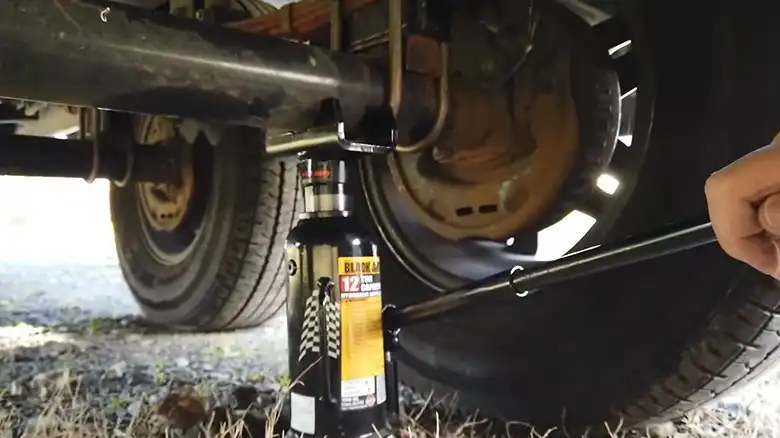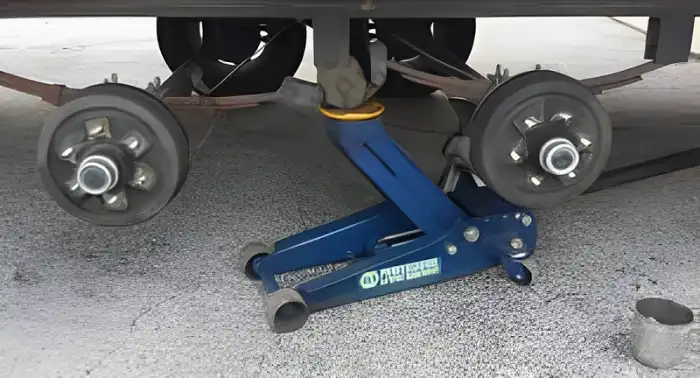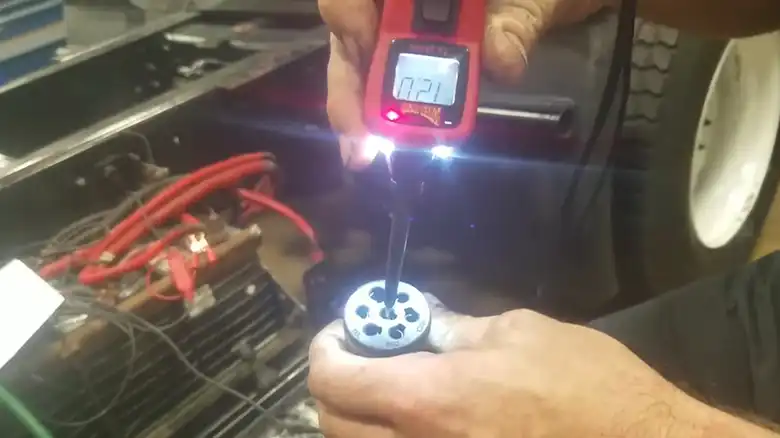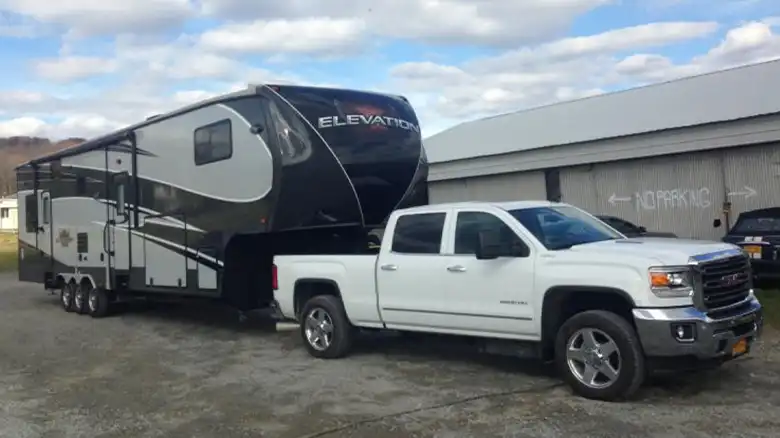As a long-time RV owner, raising and supporting my trailer to work on the wheels, axles, and underside is a skill I’ve learned through trial and error over the years. While the internet provides a wealth of information, nothing beats first-hand experience when it comes to getting the job done right. This is why I’m here to share the techniques I’ve picked up to safely jack up one side of a single-axle travel trailer. Whether you’re a novice or a seasoned DIYer, you’re sure to find some helpful pointers to make the process smooth and avoid mistakes.
So, take a few minutes and read the entire post.

Essential Tools for Jacking Up Your Travel Trailer

Source: RV.net
a) A hydraulic jack or scissor jack is capable of lifting the weight of the trailer. Make sure it’s in good working order.
b) Jack stands or jack pads to support the trailer once lifted. Sturdy concrete blocks or wood blocks can also work.
c) Wheel chocks to prevent the opposite wheels from moving.
d) A lug wrench for removing the lug nuts.
e) A socket set to fit the lug nuts.
f) The safety jack stands as an extra precaution when working under the trailer.
g) (Optional) Boards or pads to place under the jack and jack stands to prevent sinking into soft ground.
Step 1: Park and Secure the Wheels with Chocks
Park the trailer on level, solid ground. Engage the emergency brake and place wheel chocks securely against the tires diagonally opposite the one you’ll be lifting. For example, if lifting the front right tire, chock the rear left. This prevents shifting or rolling that could cause the trailer to fall off the jack.
Step 2: Loosen the Lug Nuts Before Lifting
Using the lug wrench, slightly loosen the lug nuts on the wheel you’ll be lifting. Don’t remove them fully yet. This makes it easier to get the nuts off once the tire is lifted off the ground.
Step 3: Properly Position the Jack for Stability
Place the jack directly under a designated jack point on the trailer frame close to the wheel being lifted. Consult your owner’s manual to find the manufacturer-recommended jacking points. Never jack directly on the axle or suspension components. Double-check that the jack is positioned vertically without any lean.
Step 4: Lifting the Trailer Safely
Operate the jack, raising the trailer slowly and checking for stability. Lift just until the tire clears the ground with a few extra inches of clearance. Do not yet remove the lug nuts.
Step 5: Secure the Trailer with Jack Stands
For safety, position jack stands or blocks under the trailer frame just behind the wheel well. This provides secure support in case the jack were to fail or slip. For even more safety, use two jack stands on either side of the jack.
Step 6: Remove the Tire and Perform Necessary Work
With the wheel safely supported by jack stands, fully unscrew and remove the lug nuts. Carefully pull the tire off the axle. Now you can move forward with any work needed on the brakes, hubs, axle, or suspension.
Step 7: Lower the Trailer and Tighten the Lug Nuts
When the work is complete, put the tire back on and hand-tighten the lug nuts. After double-checking that all tools and objects are cleared from under the trailer, slowly turn the jack to lower the frame onto the wheel. Remove the jack stands or blocks. Finish tightening the lug nuts completely in a star pattern for even tightening.
Step 8: Unchock the Wheels and Clean Up
Give the lug nuts a final torque with the lug wrench to spec. Then unchock the opposite wheels and stow the gear until next time. Perform a walk-around inspection to ensure the trailer is level and stable before towing.
Should You Jack Up the Trailer by the Axle?
It may seem convenient, but there are good reasons most manufacturers advise against it. Trailer axles are designed to allow wheels to spin freely, not remain static under thousands of pounds of weight. Jacking at the axle risks bending it, damaging hubs and joints, and throwing off wheel alignment. The trailer frame is reinforced with specific jacking points to properly distribute the load. While the axle provides easy access, jacking there pushes the suspension components far beyond their intended use. For safe jacking that avoids expensive repairs down the road, take the time to use quality jacks at the frame points engineered to bear the weight. Trust the trailer’s frame supports over the flexible axle.
Pros and Cons of Jacking Up a Single Axle Trailer
That’s all about the complete process of jacking up a single-axle trailer. But as you do that, does it bring any benefits or have any drawbacks? Check them out!
Here are the pros –
a) Allows access to wheels, tires, and axles for maintenance and repairs
b) Makes it easier to level and stabilize the trailer when parked
c) Can help redistribute weight off an overloaded axle
d) Allows you to get unstuck if one wheel sinks into soft ground
Here are the cons –
a) Can be dangerous if not done properly with sturdy, weight-rated jack stands
b) Risk of trailer tipping if support is only on one side
c) Difficult to do safely on unlevel or uneven ground
d) Requires physical effort and proper equipment
e) Time-consuming process compared to driving onto blocks
What You Should Consider While Jacking Up a Single Axle?
- Work on a flat, paved surface when possible. Use boards under the jack and stands if on dirt or grass.
- Apply the parking brake and chock both sets of wheels for extra security.
- Shake the trailer a bit to check that it’s completely stable on the stands before going underneath.
- Use spray lubricant on rusted or stuck lug nuts.
- Make sure your jack is rated for the full weight of the trailer.
- Always look under the trailer before fully lowering it to avoid tools or other objects getting trapped or crushed.
Conclusion
Jacking up your trailer periodically provides the opportunity to identify and address small issues before they become big problems down the road. By following sound jacking methods, you can avoid damage from a tipped or fallen trailer. As with any maintenance task, the right knowledge paired with caution and common sense will take you far. While I don’t have all the answers, I hope these lessons from my DIY journey will steer you smoothly whenever you need to raise your home on wheels. Wherever your next destination may be, safe travels!
Related Questions
How do I know where I can safely place jacks and jack stands?
Consult your owner’s manual. Most trailers have designated welded jacks and standpoints on the main frame near the wheels. Never lift on axles or suspension parts.
What type of jack should I use?
A hydraulic bottle jack or scissor jack provides the best stability. Avoid cheap, lightweight jacks prone to failure or tipping. Make sure the weight rating exceeds your trailer’s weight.
Should I remove the spare tire before jacking up that side?
Yes, remove any heavy spare tires or accessories before lifting to reduce the amount of weight being raised.


